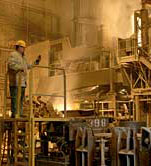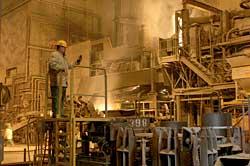
Where 'Industrial' and 'Hygiene' Join Hands
While it is important for good hygiene's sake to use gas monitors during each phase, they prove their value in the Evaluation phase.
- By Bill Smith
- May 01, 2007
 WHEN used independently of each other, the words industrial and hygiene could be construed as polar opposites. Industrial conjures up pictures of manufacturing plants, steel mills, production lines, and generally rough environments. Hygiene, on the other hand, is defined as a science of the establishment and maintenance of health.
WHEN used independently of each other, the words industrial and hygiene could be construed as polar opposites. Industrial conjures up pictures of manufacturing plants, steel mills, production lines, and generally rough environments. Hygiene, on the other hand, is defined as a science of the establishment and maintenance of health.
Not often is the rough-and-tumble, industrial world of heavy manufacturing or production confused with hygiene. Unless of course you use the words together;
in tandem, industrial hygiene has its very own independent meaning. Perhaps one of the finer definitions of industrial hygiene is, as scribed by Henry F. Smyth Jr., Ph.D., in his article published in the American Journal of Public Health (Vol.56, No.7, July, 1966, p 1120-1127):
"Industrial Hygiene is that science and art devoted to the recognition, evaluation, and control of those environmental factors or stresses, arising in or from the work place, which may cause sickness, impaired health and well-being, or significant discomfort and inefficiency among workers or among the citizens of the community."
In simpler terms, understanding your environment and eliminating or controlling its hazards is industrial hygiene.
Gas Detectors and Industrial Hygiene
Industrial hygienists and safety managers around the world are tasked daily with managing proper hygiene in a myriad of categories including, but by no means limited to, noise, personal protection, chemicals, ergonomics, and air quality. Air quality and good hygiene can become synonymous terms when gas detectors are used for, as Dr. Smyth stated, "the recognition, evaluation, and control" of the industrial atmospheres in which we work. Simply put, without the recognition, evaluation, and control of the air we work in, through the use of gas monitoring devices, the ultimate sacrifice could be made: loss of human life.
Let's break down the three main areas of Dr. Smyth's definition.
Recognition
Gas detectors are used for many purposes; recognizing the hazards in the air is one. Through the use of advanced sensor technology, such as catalytic diffusion to detect combustible gas, electrochemical to detect toxic gases and oxygen levels, and photo-ionization technology to monitor volatile organic compounds, recognizing the gas hazards can be easy.
Evaluation
Utilizing advanced sensor technology for the discovery of gas hazards leads directly to the evaluation of the air hazards present. Digital readout technology allows the user of the gas monitor to determine the hazard, detectable to the parts per million (ppm) level, and warning the user that the environment is unsafe.
Control
Simply put, once you know what your hazard levels are, you can take means to control them. One of the controls might be venting the hazardous substance; another might be to wear breathing equipment to avoid breathing tainted air. Continued utilization of the gas detector during the control phase will ensure the environment remains safe.
While it is important for good hygiene's sake to use gas monitors during each phase, they prove their value in the Evaluation phase. During this phase, there are several hygiene functions of the gas monitor and its supporting equipment that should be noted. But first, let's differentiate between using a gas monitor for safety and using it for hygiene purposes. A monitor utilized for safety purposes serves to alarm when readings of the target gas exceed the pre-determined low alarm settings programmed into the monitor. Alarms are also sounded when the environment becomes oxygen deficient or enriched. A monitor utilized for hygiene purposes has the ability not only to detect dangerous levels of explosive or toxic gas and monitor the oxygen levels in the atmosphere, but also to record atmospheric readings of the area's hygiene through a practice called datalogging.
Many of today's monitors come equipped with a datalogger--a device containing a microprocessor that stores information that is electronically taken from an instrument. The instrument can be connected to a computer or other printing device for later reference and printouts. What type of information do the dataloggers track to ensure proper hygiene of a workspace? The two most important bits of information tracked in a datalogger relating specifically to hygiene are STELs and TWAs.
STELs
STEL is an acronym for Short Term Exposure Limit and represents the average of a gas concentration a worker has been exposed to during a 15-minute period. If this amount exceeds predetermined limits, the worker must remove him/herself from the hazard for a period of at least one hour before re-entry. STEL values may be exceeded only four times during a normal work shift.
TWA
TWA is an acronym for Time Weighted Average, and it literally means the average amount of gas a worker has been exposed to over a given time period. This time is usually defined as eight hours to represent a normal workday. If a predetermined TWA value is exceeded, a worker may not re-enter the space for the balance of the work day.
STELs and TWAs are calculated by the datalogger's microprocessor by utilizing guidelines established by the American Conference of Governmental Industrial Hygienists. The guidelines list the maximum concentration of a substance a worker may be exposed to without ill affects during a normal eight-hour, five-day week. Obviously, monitoring and therefore knowing the STEL and TWA readings allows the user of the gas monitor to practice good hygiene.
In addition to STEL and TWA, datalogging captures each gas reading, temperature, instrument user ID, site ID, and time and date of sample. This is valuable information the datalogger can provide to safety professionals that helps to maintain accurate records and documentation, again ensuring good hygiene and allowing workers to confidently operate within regulated safety requirements.
All of the above information is important not only for the immediate health and well-being of workers who may be exposed to atmospheric hazards, but also for having the hygiene information documented, which will allow operators to make educated and calculated decisions on how to purge the work area and keep it clean from hazards, as discussed in the control phase.
Furthermore, the importance of gas monitoring devices to industrial hygienists and safety professionals is significant. The information that is recorded becomes the impetus for the development of a responsible, OHSA-conforming gas monitoring program. Maintenance management is also part of the hygiene function and can be greatly enhanced by taking advantage of even further evolution of gas monitoring technology.
Docking Systems
Gas detection instrument maintenance and calibration docking systems are valuable for many reasons. They can provide the following:
* Automated calibration/bump testing. OSHA mandates in 29 CFR 1910.146 that the only way to safely detect a hazardous atmosphere is with a "Calibrated direct reading instrument." Docking systems for gas detector maintenance often provide single-button calibration options to help meet the OSHA requirements. Workers no longer have to calibrate their monitors manually.
* Recordkeeping. Docking systems automatically record and store valuable information such as bump and calibration records, keeping a record of all hygiene information stored. Datalogging information is logged and stored through the event logging mode and will keep information recorded when an incident or event occurs.
* Recharging. Maintenance docking systems also can be used to charge monitors when they are not in use. This will ensure the monitor is fully charged the next time it is used.
* Instrument diagnostics. Automation and technology built into docking systems also provides a means for diagnosing potential problems with your monitor, such as low or marginal sensor life, date of the last calibration, and the number of days until the next calibration is due.
Centralized Instrument Management
The evolution of calibration and maintenance docking systems has afforded us the opportunity to utilize two-way wireless and/or Ethernet connectivity to link up to 100 stand-alone instrument docking stations from remote locations anywhere in a facility. This allows information from each station or site to be relayed back to one central database, allowing for total, centralized, instrument management. Just as important is the ability to easily and automatically recognize, evaluate, and control the safety and hygiene of your entire gas monitoring program to ensure proper industrial hygiene.
In summary, not only do the words industrial and hygiene belong together; they dovetail so perfectly when used in a proper gas monitoring program that it is a wonder they have ever been used individually.
This article originally appeared in the May 2007 issue of Occupational Health & Safety.